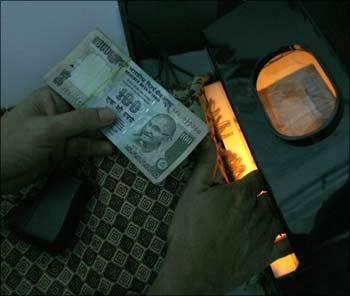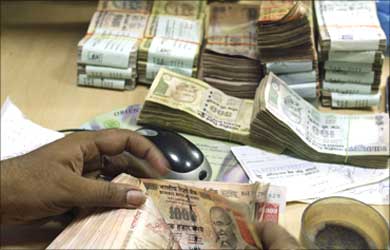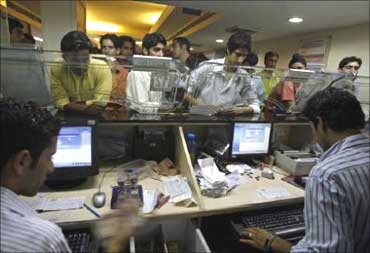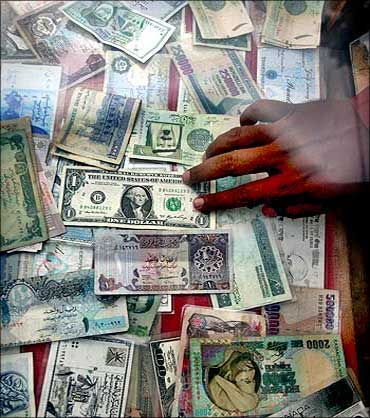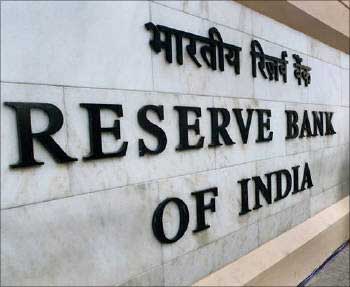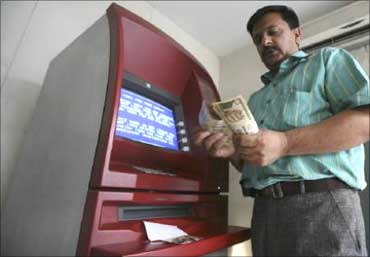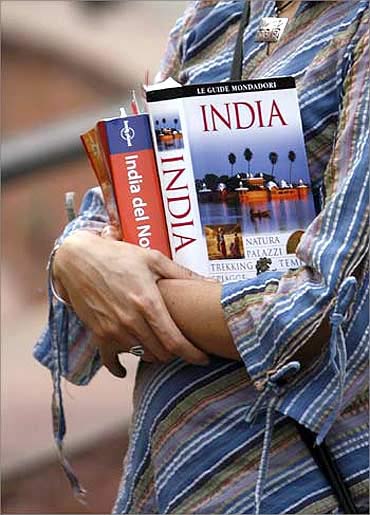 | « Back to article | Print this article |
Is the rupee really uncompetitive?
The surge in portfolio inflows over the last three weeks and the consequent appreciation of the rupee have resurrected apprehensions of a loss of export competitiveness.
The real effective exchange rate of the rupee (REER, a weighted average exchange rate measured against a basket of six currencies -- the dollar, the British pound, the euro, the yen, the Chinese yuan and the Hong Kong dollar -- adjusted for inflation difference with six economies) shows a level of 111 if you go by the Reserve Bank of India's estimates available up to the middle of August and 119 for the last week of September if one uses JP Morgan's index that is available with the least lag.
Thus compared to the base years of 2008-09 and 2003-04 that these indices respectively use, the real value of the rupee has appreciated 11 and 19 per cent, respectively.
The fact that the trade and current account deficit seem to be alarmingly large (the July trade deficit was about $13 billion) adds a sense of urgency to these concerns.
Click NEXT to read further. . .
Is the rupee really uncompetitive?
Though it is difficult to make an exact estimate since current account data is available only with a considerable lag, the consensus in the financial markets is that it is running at over 3 per cent of gross domestic product, a good percentage point over the average 2 per cent that it recorded historically.
The conclusion seems to be that the economy simply cannot afford to be saddled with a bloated currency.
Thus the RBI needs to do something to prevent this.
These concerns are indeed legitimate.
Some questions, however, need to be answered satisfactorily before lobbing the ball over to the RBI's court.
The first relates to the nature of currency competitiveness itself.
Some economists (including myself) have argued that export competitiveness should be gauged against major export competitors and not against large importers like the US, Japan or the UK that figure in the RBI's or JP Morgan's REER basket.
If we assume that some of the east-Asian economies are our key competitors, the conclusions about the loss of competitiveness could be different.
Click NEXT to read further. . .
Is the rupee really uncompetitive?
For one, barring the last three weeks, the rupee in nominal terms has actually underperformed (appreciated less) than a number of these currencies this year.
Thus, between January and mid-September the rupee appreciated by 0.5 per cent. On the other hand, the Thai baht appreciated by 7.8 per cent, the Malaysian ringitt by 9.4 cent and the Chinese yuan by 1 per cent.
Only the South Korean won seems to have underperformed.
The Bank of International Settlements computes a REER for each of the major economies against their key trading partners.
A comparison of the percentage changes in their index for a period (say January-August 2010) could thus help gauge how each currency has fared in terms of its real (inflation-adjusted) competitiveness.
The takeaway is the same as for nominal exchange rates.
The real appreciation of the rupee was smaller than most of its east- and north- Asian peers (except South Korea).
The bottom line is that if one gauges competitiveness among peer currencies, the concerns about an erosion of export advantage would appear a trifle exaggerated.
Click NEXT to read further. . .
Is the rupee really uncompetitive?
| PERFORMANCE OF ASIAN CURRENCIES IN 2010 | ||
| (In %) | Nominal | Gains/losses |
| Indian rupee | 0.5 | 3.3 |
| Singapore dollar | 4.9 | 4.0 |
| Malaysian ringgit | 9.4 | 6.2 |
| Indonesian rupiah | 4.5 | 5.3 |
| Korean won | 0.4 | -3.3 |
| Thai baht | 7.8 | 4.1 |
| Chinese yuan | 1.0 | 4.3 |
| Note: Gains/losses against the US dollar refer to the period Jan 2010-Sep 13, 2010 | Note: REER calculations are based on Bank for International Settlements' REERs | Note: Real effective exchange rate (REER) calculations from Jan 2010 to Aug 2010 |
| Source: Reuters and Bank for International Settlements | ||
Click NEXT to read further. . .
Is the rupee really uncompetitive?
The second set of questions relates to what the RBI could have done to ensure exchange competitiveness rate of the rupee.
I would argue that over the past few months, the RBI's hands have been tied.
For one, the large current account deficit and a less-than-anticipated flow of capital have meant that outflows have almost been exactly matched.
This has been reflected in a virtually static rupee with a bias towards depreciation. Typically, the RBI intervenes by buying surplus dollars from the market.
As any foreign exchange trader would point out, there simply haven't been any dollar surpluses left for the RBI to buy from the market in the past few months. In short, the scope for intervention has been severely limited.
It is possible to argue that despite this knife-edge balance, the RBI could have steeped in to buy dollars.
This would have created excess dollar demand and caused the rupee to depreciate, keeping the REER in check. This seems like a theoretically neat proposition.
However, any dollar buying by the RBI would have unwound surplus liquidity in the markets since the central bank sells rupees to the market in exchange for dollars when it intervenes.
Click NEXT to read further. . .
Is the rupee really uncompetitive?
At a time when the RBI appears to have been attempting to excise excess liquidity from the market to thwart inflationary pressures, foreign exchange market intervention would appear a little inconsistent.
The persistence of high inflation has added another twist.
The REER factors in both inflation and the nominal exchange rate.
It seems clear, given the movement in the nominal exchange rate and inflation, that a significant proportion of the rupee's overvaluation this year was in fact driven by rising domestic inflation.
Domestic inflation, in turn, was driven by local commodity inflation, principally of agriculture products.
In inflationary episodes like this, the option of augmenting domestic supply through imports remains a critical policy option.
Allowing the rupee to depreciate would lead to an increase in the cost of imports and potentially add to inflation.
Thus, the gains from a depreciated rupee could have been eroded by depreciation-driven inflation.
But tomorrow is another day.
Click NEXT to read further. . .
Is the rupee really uncompetitive?
The fact that the RBI has not had scope or perhaps reason to do much in the past does not mean that it needs to do nothing in the future.
Given the rupee's momentum, some intervention is perhaps needed at this stage. However, before contemplating something as severe as capital controls, the RBI needs to get a couple of things right.
First, it needs to gauge competitiveness correctly.(All Asian currencies have incidentally gained in this phase.)
Second, capital controls have a habit of sending adverse signals and impinge on flows other than just portfolio flows.
Given the huge resource needs of infrastructure and company capex, it is important to ensure that there is enough external capital available.
By easing the caps on investment in bonds (thereby enabling more capital flows), the finance ministry has signalled that it is willing to trade the relatively short-term consequences of the rupee appreciation for long-term resource adequacy.
The RBI should perhaps look before it leaps.
